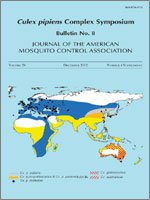The present study examines the mating and breeding behavior as well as the genetic differentiation of Culex pipiens biotype pipiens and Cx. pipiens biotype molestus. Firstly, the mating behavior of Cx. pipiens s.l. originating from larval populations of various epigeous and hypogeous breeding sites in Germany was examined. Autogeny was prevailing in underground populations, occasionally found in semi-open water reservoirs like drains, rarely in containers, but never in ponds and ditches. Secondly, in a multilocus enzyme electrophoretic study the gene flow among seven geographic populations of Cx. pipiens biotype pipiens and the biotype molestus from several European countries was quantified. For comparison, five populations of Cx. quinquefasciatus from Asia, Africa and North America, three populations of Cx. torrentium (Germany) and other outgroup species were also examined. Thirdly, the mitochondrial cytochrome c oxidase submit I gene of both biotypes from Germany was analysed by a polymerase chain reaction – restriction fragment length polymorphism assay and the ascertained DNA-sequences were aligned with genebank data of Russian populations. The population genetic analyses revealed much higher genetic distances between local populations of Cx. pipiens biotype pipiens and Cx. pipiens biotype molestus compared to the low differentiation between geographically remote populations within each taxon. The UPGMA (unweighted pair group method with arithmetic mean) analysis and F-statistics positioned the biotypes pipiens on one side and molestus on the other side in discrete monophyletic clusters. Gene flow between local populations of the biotypes pipiens and molestus could be shown to be lower than gene flow between geographically distant populations within each of the two groups, leading to the conclusion that Cx. pipiens biotype molestus could be a distinct taxon. Culex quinquefasciatus was genetically well-separated, in particular by the diagnostic enzyme marker malate dehydrogenase (nicotinamide adenine dinucleotide phosphate). The genetic markers adenylatekinase and hydrobutyrate dehydrogenase allowed to screen thousands of morphologically similar samples of either Cx. pipiens s.l. and Cx torrentium and it could be shown that Cx. torrentium is a very frequent species in central Europe.
How to translate text using browser tools
1 December 2012
The Culex pipiens Complex in Europe
Norbert Becker,
Artur Jöst,
Thomas Weitzel
ACCESS THE FULL ARTICLE
It is not available for individual sale.
This article is only available to subscribers.
It is not available for individual sale.
It is not available for individual sale.
autogeny
biochemical taxonomy
Culex pipiens complex
Europe





